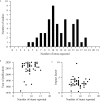A Handful of Details to Ensure the Experimental Reproducibility on the FORCED Running Wheel in Rodents: A Systematic Review
- PMID: 34040580
- PMCID: PMC8141847
- DOI: 10.3389/fendo.2021.638261
A Handful of Details to Ensure the Experimental Reproducibility on the FORCED Running Wheel in Rodents: A Systematic Review
Abstract
A well-documented method and experimental design are essential to ensure the reproducibility and reliability in animal research. Experimental studies using exercise programs in animal models have experienced an exponential increase in the last decades. Complete reporting of forced wheel and treadmill exercise protocols would help to ensure the reproducibility of training programs. However, forced exercise programs are characterized by a poorly detailed methodology. Also, current guidelines do not cover the minimum data that must be included in published works to reproduce training programs. For this reason, we have carried out a systematic review to determine the reproducibility of training programs and experimental designs of published research in rodents using a forced wheel system. Having determined that most of the studies were not detailed enough to be reproducible, we have suggested guidelines for animal research using FORCED exercise wheels, which could also be applicable to any form of forced exercise.
Keywords: animal research; forced exercise; forced wheel; research guidelines; rodent exercise.
Copyright © 2021 Garrigos, Martínez-Morga, Toval, Kutsenko, Barreda, Do Couto, Navarro-Mateu and Ferran.
Conflict of interest statement
The authors declare that the research was conducted in the absence of any commercial or financial relationships that could be construed as a potential conflict of interest.
Figures





Similar articles
-
Improved infrared-sensing running wheel systems with an effective exercise activity indicator.PLoS One. 2015 Apr 13;10(4):e0122394. doi: 10.1371/journal.pone.0122394. eCollection 2015. PLoS One. 2015. PMID: 25875841 Free PMC article.
-
A forced running wheel system with a microcontroller that provides high-intensity exercise training in an animal ischemic stroke model.Braz J Med Biol Res. 2014 Oct;47(10):858-68. doi: 10.1590/1414-431x20143754. Epub 2014 Aug 15. Braz J Med Biol Res. 2014. PMID: 25140816 Free PMC article.
-
Serotonin-mediated central fatigue underlies increased endurance capacity in mice from lines selectively bred for high voluntary wheel running.Physiol Behav. 2016 Jul 1;161:145-154. doi: 10.1016/j.physbeh.2016.04.033. Epub 2016 Apr 19. Physiol Behav. 2016. PMID: 27106566
-
Voluntary exercise and depression-like behavior in rodents: are we running in the right direction?J Mol Endocrinol. 2018 Apr;60(3):R77-R95. doi: 10.1530/JME-17-0165. Epub 2018 Jan 12. J Mol Endocrinol. 2018. PMID: 29330149 Review.
-
The use of a running wheel to measure activity in rodents: relationship to energy balance, general activity, and reward.Neurosci Biobehav Rev. 2012 Mar;36(3):1001-1014. doi: 10.1016/j.neubiorev.2011.12.012. Epub 2012 Jan 2. Neurosci Biobehav Rev. 2012. PMID: 22230703 Free PMC article. Review.
Cited by
-
A Proposal for a Noxious Stimuli-Free, Moderate-Intensity Treadmill Running Protocol to Improve Aerobic Performance in Experimental Research on Rats.Metabolites. 2024 Oct 4;14(10):534. doi: 10.3390/metabo14100534. Metabolites. 2024. PMID: 39452915 Free PMC article.
-
Sexual dimorphism in response to repetitive bouts of acute aerobic exercise in rodents with type 1 diabetes mellitus.PLoS One. 2022 Sep 9;17(9):e0273701. doi: 10.1371/journal.pone.0273701. eCollection 2022. PLoS One. 2022. PMID: 36083870 Free PMC article.
-
Multi-neuromeric origin of tyrosine hydroxylase-positive neurons within the substantia nigra and ventral tegmental area.Front Neuroanat. 2025 May 30;19:1612529. doi: 10.3389/fnana.2025.1612529. eCollection 2025. Front Neuroanat. 2025. PMID: 40519251 Free PMC article.
-
Prosomeric Hypothalamic Distribution of Tyrosine Hydroxylase Positive Cells in Adolescent Rats.Front Neuroanat. 2022 May 6;16:868345. doi: 10.3389/fnana.2022.868345. eCollection 2022. Front Neuroanat. 2022. PMID: 35601999 Free PMC article.
-
Circadian Synchrony: Sleep, Nutrition, and Physical Activity.Front Netw Physiol. 2021 Oct;1:732243. doi: 10.3389/fnetp.2021.732243. Epub 2021 Oct 12. Front Netw Physiol. 2021. PMID: 35156088 Free PMC article.
References
-
- Rice AS, Cimino-Brown D, Eisenach JC, Kontinen VK, Lacroix-Fralish ML, Machin I, et al. . Animal Models and the Prediction of Efficacy in Clinical Trials of Analgesic Drugs: A Critical Appraisal and Call for Uniform Reporting Standards. Pain (2008) 139(2):243–7. 10.1016/j.pain.2008.08.017 - DOI - PubMed
Publication types
MeSH terms
LinkOut - more resources
Full Text Sources
Other Literature Sources

